Back when I wanted to be an aerospace engineer, I did some research and came away with the following understanding of how things worked:
1. Scientists do the theoretical stuff.
2. Engineers design stuff, solve problems, and apply the scientists' theory.
3. Technicians install/build/make what the engineers designed.
A semester of engineering school made it abundantly clear I was not destined to be an engineer. So I've been trying to decide ever since...Where do I fit in this hierarchy?
Now I have realized some key truths:
1. Engineers, bless their hearts, often lack on-the-shop-floor experience, which can cause problems in the design process.
2. There are actually more than three positions in that 1-2-3 hierarchy.
3. Especially under sub-optimal conditions, the lines between Engineer and Technician are often blurred.
4. People who are good at their thing often have a lot of knowledge that overlaps with the areas around them--e.g. good engineers know a lot about technicians' jobs.
College Visit: Appalachian State University
I am in Boone, North Carolina, today to visit Appalachian State University, and particularly their Appropriate Technology department.
I'm scheduled to visit a renewable energy class, meet with the professor afterward, then meet with an admissions person.
In the afternoon I'm headed to Raleigh for a visit with Andrew Stewart from the [Frame] list. Photos to come.
Having done a few of these college visits as a prospective transfer student (RISD, VCU, John Tyler Community College, Hampshire), some guidelines have emerged:
- Ignore the official tour and information session. These tend to be filled with general info on the whole school (easily found elsewhere), and are usually geared toward high schoolers and their parents. They also consume valuable time that could be spent getting a more hands-on look.
- Get a map of campus ahead of time. Figure out the basic lay of the land so you know how to wander around. Find the dining hall, admissions, the student commons, the relevant academic buildings, and whatever else interests you.
- Spend your time with professors and students. These are the people you'll potentially be working with. They know the real deal, and they'll tell you, if you play your cards right.
- Set up a meeting with at least one important professor. Sit in on an interesting class if possible. Do this with plenty of advance notice.
- Get a good look at the facilities and the shops. These say a lot about the priorities of the school, the department, and the professors.
- As my sister says, the most important question is: "What are your graduates doing now?".
- Eat at a place you'd likely eat at as a student. Ditto coffee and beer.
- Buy a t-shirt. And a postcard.
- Send thank-you notes to the people who helped you. Better yet, send them something small that they seem to need.
- Come across as eager, enthusiastic, driven, and all that, but don't over-do it. Make an impression. Be memorable. This isn't hard--not many prospective students do this kind of visit. I am finding that 90% of success in academia (anything?) is due to good name recognition (a.k.a. networking).
- Even if this school won't work out, you can still learn a lot during your visit. These professors probably know their counterparts elsewhere. They definitely know the big names in their field. And they probably like helping enthusiastic students.
I'm scheduled to visit a renewable energy class, meet with the professor afterward, then meet with an admissions person.
In the afternoon I'm headed to Raleigh for a visit with Andrew Stewart from the [Frame] list. Photos to come.
Having done a few of these college visits as a prospective transfer student (RISD, VCU, John Tyler Community College, Hampshire), some guidelines have emerged:
- Ignore the official tour and information session. These tend to be filled with general info on the whole school (easily found elsewhere), and are usually geared toward high schoolers and their parents. They also consume valuable time that could be spent getting a more hands-on look.
- Get a map of campus ahead of time. Figure out the basic lay of the land so you know how to wander around. Find the dining hall, admissions, the student commons, the relevant academic buildings, and whatever else interests you.
- Spend your time with professors and students. These are the people you'll potentially be working with. They know the real deal, and they'll tell you, if you play your cards right.
- Set up a meeting with at least one important professor. Sit in on an interesting class if possible. Do this with plenty of advance notice.
- Get a good look at the facilities and the shops. These say a lot about the priorities of the school, the department, and the professors.
- As my sister says, the most important question is: "What are your graduates doing now?".
- Eat at a place you'd likely eat at as a student. Ditto coffee and beer.
- Buy a t-shirt. And a postcard.
- Send thank-you notes to the people who helped you. Better yet, send them something small that they seem to need.
- Come across as eager, enthusiastic, driven, and all that, but don't over-do it. Make an impression. Be memorable. This isn't hard--not many prospective students do this kind of visit. I am finding that 90% of success in academia (anything?) is due to good name recognition (a.k.a. networking).
- Even if this school won't work out, you can still learn a lot during your visit. These professors probably know their counterparts elsewhere. They definitely know the big names in their field. And they probably like helping enthusiastic students.
Green Manufacturing
***What follows is the introduction I wrote to a group paper for Production/Operations Management class.***
There is a fundamental contradiction in the phrase “green manufacturing”. The process of making nearly anything will, by necessity, consume resources and produce waste:
Buying the results of these processes, Americans have been consuming resources at an unsustainable rate in a breathless quest for increased quality of life.(2) The US population increased threefold from 1900 and 1995, while total materials use increased tenfold.(3)
Thus our industrial future will conform to one of three basic scenarios. Commerce and industry could continue operating as they have, driven largely by economic growth and consumer demand. Or we could transition to a “green world”, where sustainability and environmental impact become major factors in design, manufacture, and use of products. Or we could enter a “brown world”, where concerns like sustainability are grossly superseded by interests such as short-term economic gain and consumer convenience. Which of these scenarios becomes our reality is largely a function of choosing how we use technology, not the rate of technological change or economic growth.(5)
The process of making manufacturing “greener” is often perceived to happen only at significant economic cost. This may be the case when an “end-of-pipe” solution is used, like a treatment device added to the end of a smokestack or sewer pipe.(6) But when process and product are examined with an eye toward reducing waste, the results often include increased productivity.
Reasonably successful businesses may be understandably reluctant to implement such changes, since potential risks of failure may seem to outweigh immediate profit gains. In this way, “green” manufacturing is a lot like Lean manufacturing, or most any other system of process improvement. There are up-front costs, but these can pay dividends for years to come.(7) In green manufacturing, there is an added benefit in making the whole economy more sustainable, thereby further ensuring future profits.
1 Thomas Graedel and Jennifer Howard-Grenville, Greening the Industrial Facility: Perspectives, Approaches, and Tools (New York: Springer, 2005) 6
2 Ibid 13, 15
3 Ibid 15
4 Ibid 16
5 Ibid 10
6 Curtis Moore and Alan Miller, Green Gold: Japan, Germany, the United States, and the Race for Environmental Technology (Boston: Beacon, 1994) 2
7 Ibid 4
There is a fundamental contradiction in the phrase “green manufacturing”. The process of making nearly anything will, by necessity, consume resources and produce waste:
Buying the results of these processes, Americans have been consuming resources at an unsustainable rate in a breathless quest for increased quality of life.(2) The US population increased threefold from 1900 and 1995, while total materials use increased tenfold.(3)
Thus our industrial future will conform to one of three basic scenarios. Commerce and industry could continue operating as they have, driven largely by economic growth and consumer demand. Or we could transition to a “green world”, where sustainability and environmental impact become major factors in design, manufacture, and use of products. Or we could enter a “brown world”, where concerns like sustainability are grossly superseded by interests such as short-term economic gain and consumer convenience. Which of these scenarios becomes our reality is largely a function of choosing how we use technology, not the rate of technological change or economic growth.(5)
The process of making manufacturing “greener” is often perceived to happen only at significant economic cost. This may be the case when an “end-of-pipe” solution is used, like a treatment device added to the end of a smokestack or sewer pipe.(6) But when process and product are examined with an eye toward reducing waste, the results often include increased productivity.
Reasonably successful businesses may be understandably reluctant to implement such changes, since potential risks of failure may seem to outweigh immediate profit gains. In this way, “green” manufacturing is a lot like Lean manufacturing, or most any other system of process improvement. There are up-front costs, but these can pay dividends for years to come.(7) In green manufacturing, there is an added benefit in making the whole economy more sustainable, thereby further ensuring future profits.
1 Thomas Graedel and Jennifer Howard-Grenville, Greening the Industrial Facility: Perspectives, Approaches, and Tools (New York: Springer, 2005) 6
2 Ibid 13, 15
3 Ibid 15
4 Ibid 16
5 Ibid 10
6 Curtis Moore and Alan Miller, Green Gold: Japan, Germany, the United States, and the Race for Environmental Technology (Boston: Beacon, 1994) 2
7 Ibid 4
3D Brake Pivot Jig Mk 2
*** Anyone wondering what the hell this is all about should go back one post***
Another night, another brake pivot jig. I'm getting better with Inventor; I made all this from scratch in less than 2.5 hours, and even worked on some actual schoolwork during that time.
• Distance between pivots is adjustable from 2.25" to 3.5" IIRC...2.5" is stock width for Dia-Compe centerpulls.
• All indexing slots are 1/4". All hardware is M6, colored gold for jig bling. The brake pivots are included now, colored gray.
• The Backbone Bar is now 1/2" x 3/4" steel. It's 15" long in this rendering, but that's subject to change.
• This design is more complicated and requires more milling, but it was designed to solve a few problems inherent in the last one. Those problems are described here and here.
• I am thinking of using steel for everything, but alu could be used judiciously.
• As drawn, this can be made from the following:
- about 18" of 1/2" x 3/4", in two pieces
- enough 3/4" round for the dummy axle(s)
- a few inches of 3/4" square
(plus a few inches of 1/2" round for the brake pivots)
• I think it's possible to make revisions such that 3/4" round and 1/2" x 3/4" are the only required sizes for the jig itself.
Assembly top view. Dropouts go on the left side.
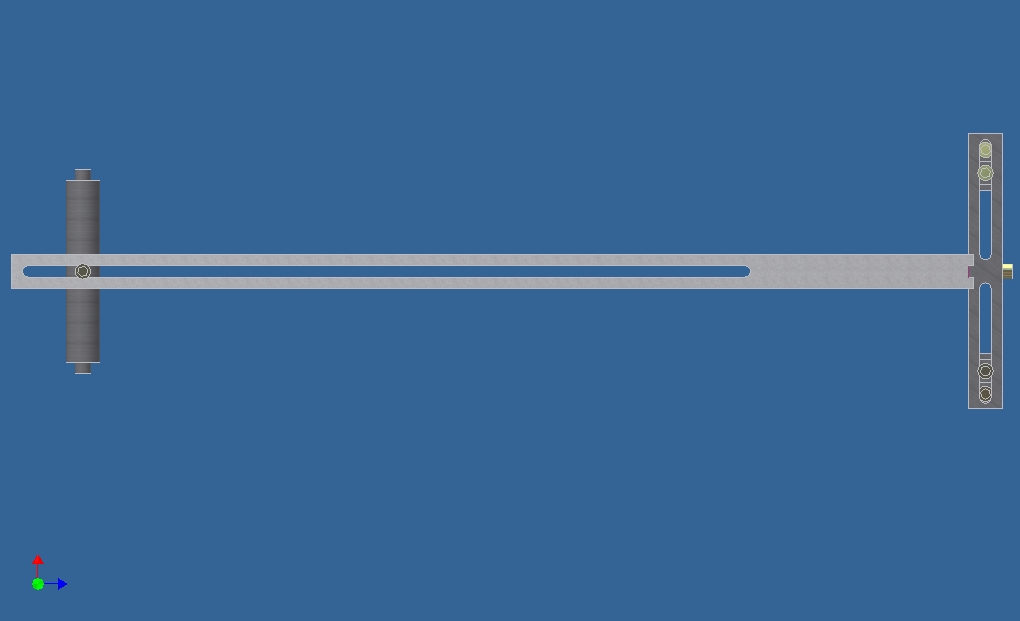
"Crotch shot" looking up from the bottom of the fork.
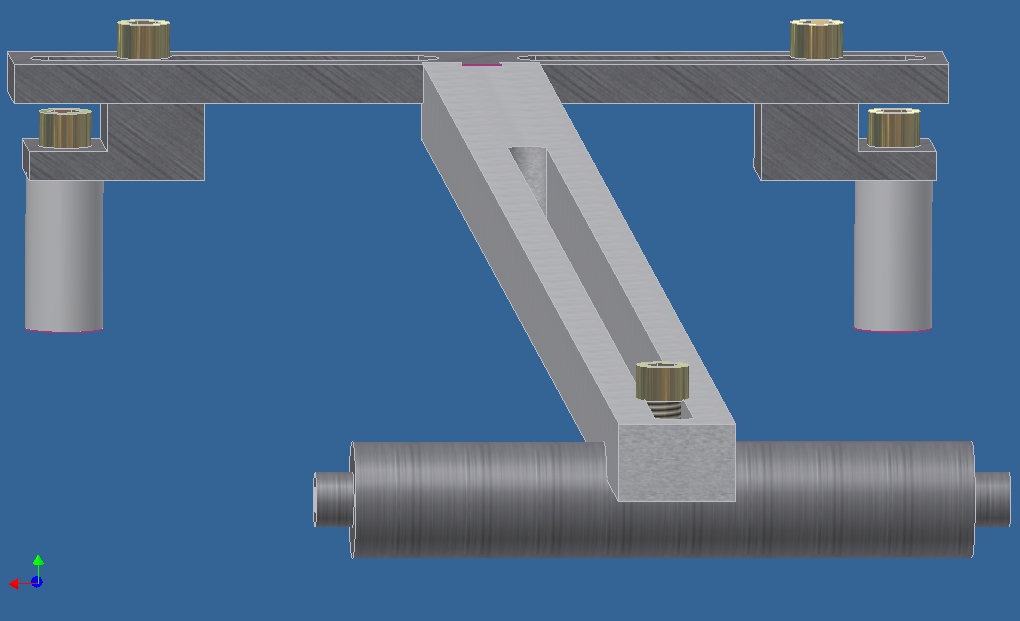
Isometric view from top right of fork.
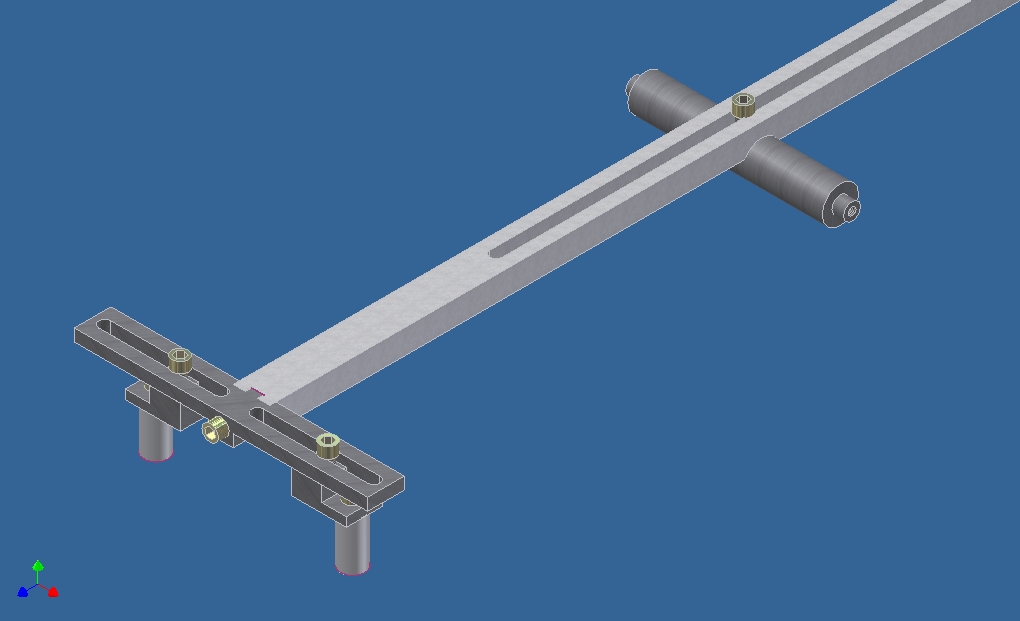
Isometric detail view. The pivots aren't symmetric, and it's bothering me a little, but I had to upload in a hurry.
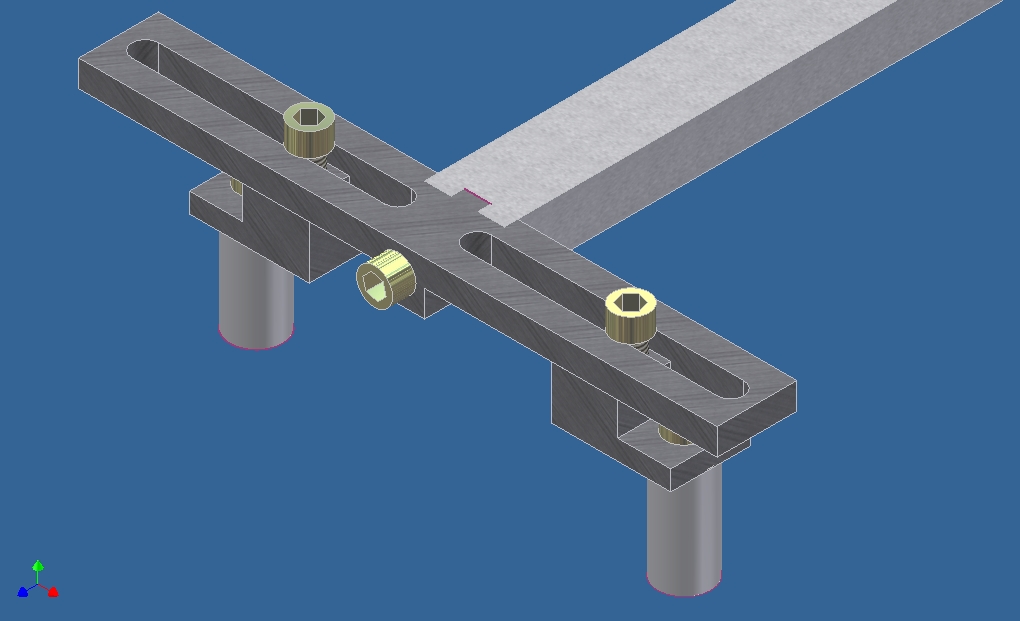
Assembly side view.

Isometric dummy axle view. It has two 1/4" wide slots milled into it, then drilled/tapped M6. This would (I'm pretty sure) be compatible with Bringheli jigs.
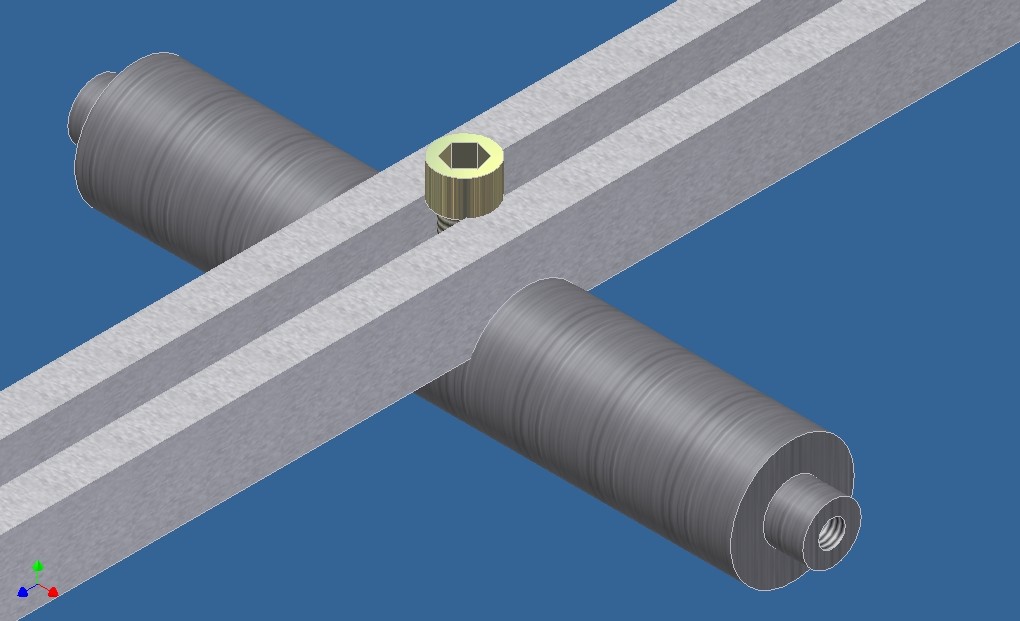
Top view detail.
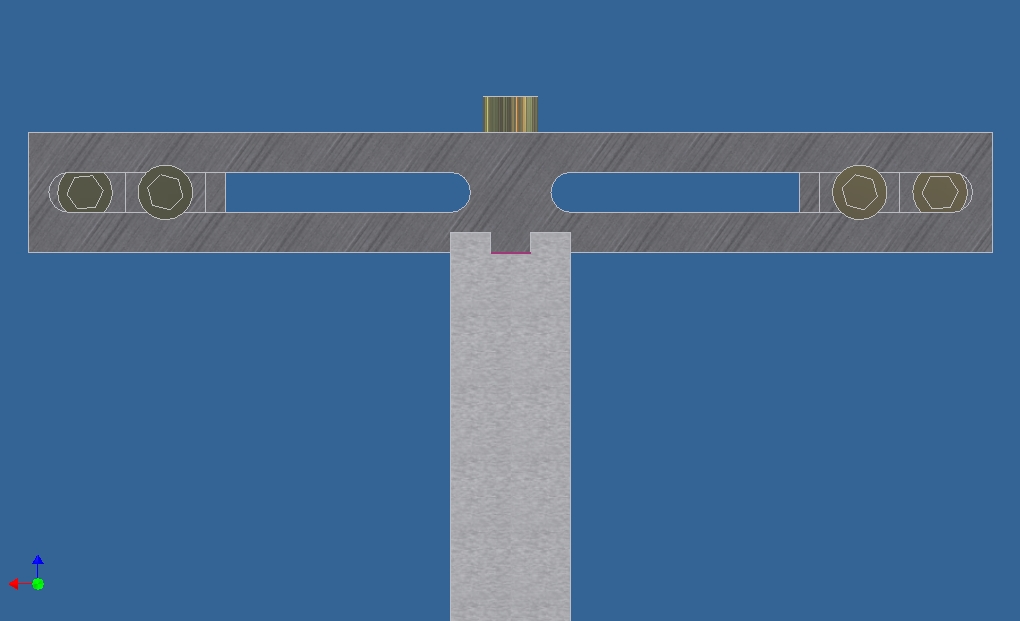
Bottom view detail. You can see that the brake pivots are hollow, and showing the gold-colored M6 bolts that holds each of them to the mating piece.
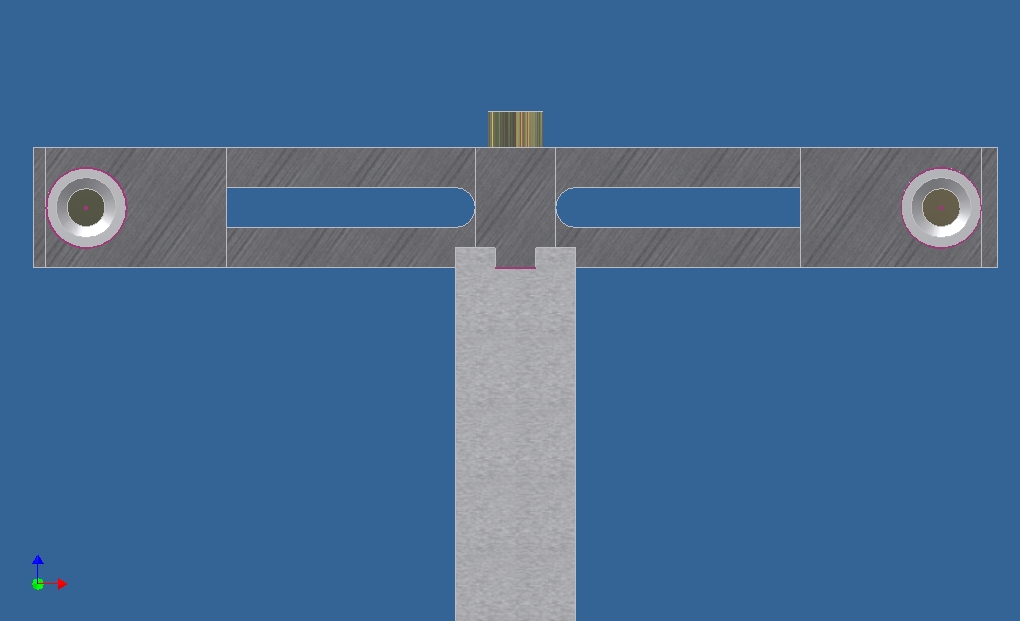
View looking down steerer tube.
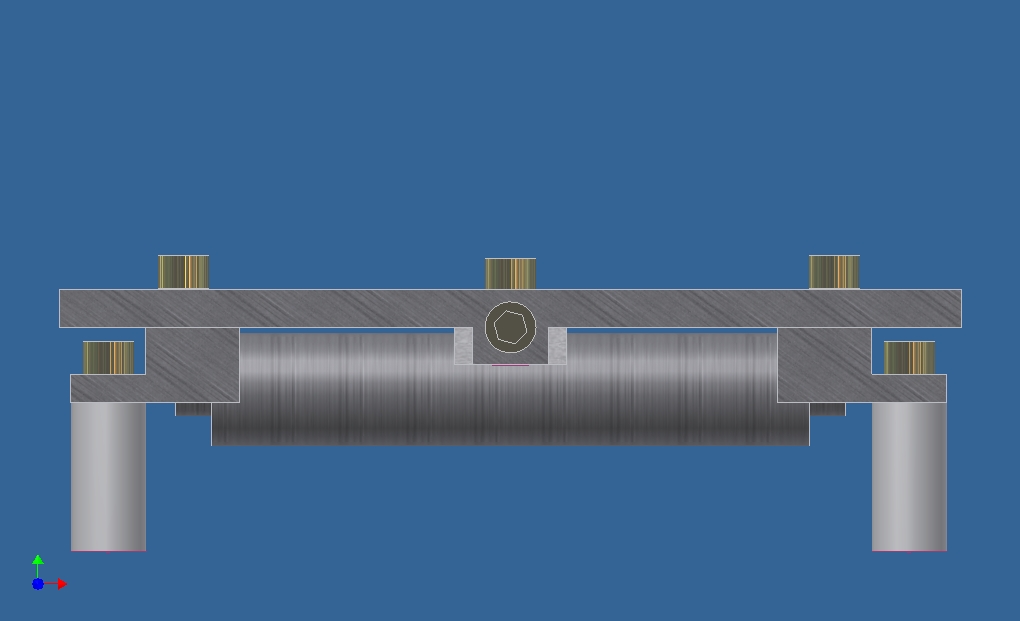
Another night, another brake pivot jig. I'm getting better with Inventor; I made all this from scratch in less than 2.5 hours, and even worked on some actual schoolwork during that time.
• Distance between pivots is adjustable from 2.25" to 3.5" IIRC...2.5" is stock width for Dia-Compe centerpulls.
• All indexing slots are 1/4". All hardware is M6, colored gold for jig bling. The brake pivots are included now, colored gray.
• The Backbone Bar is now 1/2" x 3/4" steel. It's 15" long in this rendering, but that's subject to change.
• This design is more complicated and requires more milling, but it was designed to solve a few problems inherent in the last one. Those problems are described here and here.
• I am thinking of using steel for everything, but alu could be used judiciously.
• As drawn, this can be made from the following:
- about 18" of 1/2" x 3/4", in two pieces
- enough 3/4" round for the dummy axle(s)
- a few inches of 3/4" square
(plus a few inches of 1/2" round for the brake pivots)
• I think it's possible to make revisions such that 3/4" round and 1/2" x 3/4" are the only required sizes for the jig itself.
Assembly top view. Dropouts go on the left side.

"Crotch shot" looking up from the bottom of the fork.

Isometric view from top right of fork.

Isometric detail view. The pivots aren't symmetric, and it's bothering me a little, but I had to upload in a hurry.

Assembly side view.

Isometric dummy axle view. It has two 1/4" wide slots milled into it, then drilled/tapped M6. This would (I'm pretty sure) be compatible with Bringheli jigs.

Top view detail.

Bottom view detail. You can see that the brake pivots are hollow, and showing the gold-colored M6 bolts that holds each of them to the mating piece.

View looking down steerer tube.

Modelling the Brake Pivot Jig
I am slowly learning some 3D parametric solid modelling with AutoDesk Inventor. As a first project, I have modeled the brake pivot jig I described a while back.
These drawings are pretty close to what I drew in that earlier post, although not all of the parts exist yet. A computer model conveys the concept better than the existing parts could.
These drawings are missing the brake pivots themselves, as well as all the metric set screws, clamping bolts, washers, etc.
Also conspicuously missing is the fork, which would provide context. Here's the best I can do. This is the jig that inspired this new design:

Now the model of the new jig...
Isometric view from dropout end. This is common fork jig positioning (e.g. Anvil, Bringheli).

Similar view, but flipped over--this would be showing the fork's back/underside.

Isometric view of Dummy Axle, Dummy Axle Holder Block, and Backbone Bar.

The dummy axle design is inspired directly by Anvil. The mating Block should be compatible, should I decide to upgrade.
Isometric view of Pivot Holder Block, Pivot Holder, and Backbone Bar.
Lower set screw hole is mirrored on the far side, as can be seen in other views.
These two set screws (only one is necessary at a time) hold the Pivot Holder at the proper 90° angle. I also hope the threaded holes can be used to hold chainstay and seatstay bridges in position for brazing, using a pre-brazed fender mounting boss.

Assembly side view. Distance between blocks is infinitely adjustable.

Looking down through the fork's steerer tube. This would be what the rider would see if a whole host of unlikely things happened (jig in place of front wheel, transparent frameset).

Weird pseudo-end view, looking up the fork from the dropout/bottom end.

So, what do you think?
These drawings are pretty close to what I drew in that earlier post, although not all of the parts exist yet. A computer model conveys the concept better than the existing parts could.
These drawings are missing the brake pivots themselves, as well as all the metric set screws, clamping bolts, washers, etc.
Also conspicuously missing is the fork, which would provide context. Here's the best I can do. This is the jig that inspired this new design:

Now the model of the new jig...
Isometric view from dropout end. This is common fork jig positioning (e.g. Anvil, Bringheli).

Similar view, but flipped over--this would be showing the fork's back/underside.

Isometric view of Dummy Axle, Dummy Axle Holder Block, and Backbone Bar.

The dummy axle design is inspired directly by Anvil. The mating Block should be compatible, should I decide to upgrade.
Isometric view of Pivot Holder Block, Pivot Holder, and Backbone Bar.
Lower set screw hole is mirrored on the far side, as can be seen in other views.
These two set screws (only one is necessary at a time) hold the Pivot Holder at the proper 90° angle. I also hope the threaded holes can be used to hold chainstay and seatstay bridges in position for brazing, using a pre-brazed fender mounting boss.

Assembly side view. Distance between blocks is infinitely adjustable.

Looking down through the fork's steerer tube. This would be what the rider would see if a whole host of unlikely things happened (jig in place of front wheel, transparent frameset).

Weird pseudo-end view, looking up the fork from the dropout/bottom end.

So, what do you think?
Back from the Cirque
Le Cirque was le oven, but the bikes were sweet and I met a bunch of cool people.
The only substantial food for sale was, inexplicably, German. And delicious.
Photos soon...plenty of time tomorrow to edit 346 photos.
A certain Mr. Sachs sold me a copy of his DVD, which I'll eventually review. Stay tuned.
The only substantial food for sale was, inexplicably, German. And delicious.
Photos soon...plenty of time tomorrow to edit 346 photos.
A certain Mr. Sachs sold me a copy of his DVD, which I'll eventually review. Stay tuned.
Le Cirque du Cyclisme
As Chris K mentioned, this year's Cirque du Cyclisme is being held June 6-8 in Leesburg, VA, only a couple hours' drive from here.
This promises to be the vintage bike event of the year...which sounds either really awesome (as it does to you and I) or infinitely dull (as it does to my family).
Alas, I can only afford to attend Sunday's swap meet. Extensive framebuilding coverage is planned.
I look forward to meeting/worshiping/chatting with:
Andy Stewart
Peter Weigle
Daves Wages of Ellis Cycles
Richard Sachs
Chris K of Velo Orange
Scott Clark from the i-BOB email list
Jamie Swan of Centerport Cycles
Drew Guldalian of Wissahickon Cyclery (retail bike shop) and Engin Cycles (frame shop)
Charles Lathe of Coho Bicycles
Elton Pope-Lance of Harris Cyclery
Joseph Ahearne of Ahearne Cycles
Mitch Pryor of MAP Cycles
Brian Baylis
Matt Klucha of MSH1
Mark Nobilette
Mauricio Rebolledo
The Bilenky Cycle Works gang
Joe Bringheli
Johnny Coast
[Update: expanded to include this list]
Who am I missing?
This promises to be the vintage bike event of the year...which sounds either really awesome (as it does to you and I) or infinitely dull (as it does to my family).
Alas, I can only afford to attend Sunday's swap meet. Extensive framebuilding coverage is planned.
I look forward to meeting/worshiping/chatting with:
Andy Stewart
Peter Weigle
Daves Wages of Ellis Cycles
Richard Sachs
Chris K of Velo Orange
Scott Clark from the i-BOB email list
Jamie Swan of Centerport Cycles
Drew Guldalian of Wissahickon Cyclery (retail bike shop) and Engin Cycles (frame shop)
Charles Lathe of Coho Bicycles
Elton Pope-Lance of Harris Cyclery
Joseph Ahearne of Ahearne Cycles
Mitch Pryor of MAP Cycles
Brian Baylis
Matt Klucha of MSH1
Mark Nobilette
Mauricio Rebolledo
The Bilenky Cycle Works gang
Joe Bringheli
Johnny Coast
[Update: expanded to include this list]
Who am I missing?
Hampshire/Lemelson Update
I have it on good authority that funding for Hampshire College's Lemelson Center will likely decrease next year, meaning fewer courses will be offered. This is unfortunate given the potential that exists there.
Moreover, the framebuilding course is one of the more expensive and is thus more likely to be cut. Sad news.
Moreover, the framebuilding course is one of the more expensive and is thus more likely to be cut. Sad news.
Subscribe to:
Posts (Atom)





